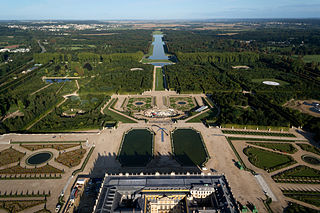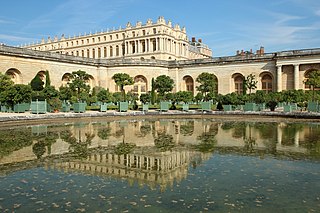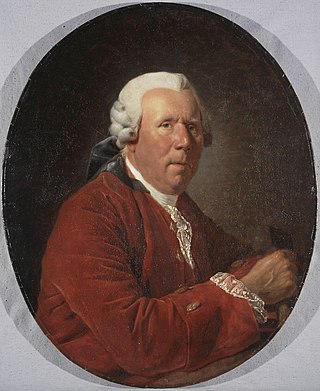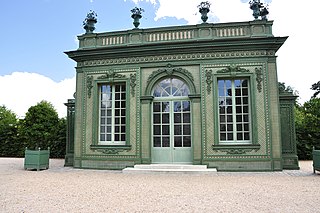
The Palace of Versailles is a former royal residence commissioned by King Louis XIV located in Versailles, about 19 kilometers (12 mi) west of Paris, France.

Jules Hardouin-Mansart was a French Baroque architect and builder whose major work included the Place des Victoires (1684–1690); Place Vendôme (1690); the domed chapel of Les Invalides (1690), and the Grand Trianon of the Palace of Versailles. His monumental work was designed to glorify the reign of Louis XIV of France.

François Girardon was a French sculptor of the Louis XIV style or French Baroque, best known for his statues and busts of Louis XIV and for his statuary in the gardens of the Palace of Versailles.

The Château de Marly was a French royal residence located in what is now Marly-le-Roi, the commune on the northern edge of the royal park. This was situated west of the palace and garden complex at Versailles. Marly-le-Roi is the town that developed to serve the château, which was demolished in 1806 after passing into private ownership and being used as a factory. The town is now a bedroom community for Paris.

Ange-Jacques Gabriel was the principal architect of King Louis XV of France. His major works included the Place de la Concorde, the École Militaire, and the Petit Trianon and opera theater at the Palace of Versailles. His style was a careful balance between French Baroque architecture and French neoclassicism.

French Baroque architecture, usually called French classicism, was a style of architecture during the reigns of Louis XIII (1610–1643), Louis XIV (1643–1715) and Louis XV (1715–1774). It was preceded by French Renaissance architecture and Mannerism and was followed in the second half of the 18th century by French Neoclassical architecture. The style was originally inspired by the Italian Baroque architecture style, but, particularly under Louis XIV, it gave greater emphasis to regularity, the colossal order of façades, and the use of colonnades and cupolas, to symbolize the power and grandeur of the King. Notable examples of the style include the Grand Trianon of the Palace of Versailles, and the dome of Les Invalides in Paris. In the final years of Louis XIV and the reign of Louis XV, the colossal orders gradually disappeared, the style became lighter and saw the introduction of wrought iron decoration in rocaille designs. The period also saw the introduction of monumental urban squares in Paris and other cities, notably Place Vendôme and the Place de la Concorde. The style profoundly influenced 18th-century secular architecture throughout Europe; the Palace of Versailles and the French formal garden were copied by other courts all over Europe.

Pierre Le Gros the Elder was a French sculptor in the service of King Louis XIV.

Jean-Baptiste Tuby was a French sculptor of Italian origins, best known for the sculpture in the fountains of the Gardens of Versailles. His work expresses the exuberance of the Baroque blended with the classicism of the Louis XIV style.

The Gardens of Versailles occupy part of what was once the Domaine royal de Versailles, the royal demesne of the château of Versailles. Situated to the west of the palace, the gardens cover some 800 hectares of land, much of which is landscaped in the classic French formal garden style perfected here by André Le Nôtre. Beyond the surrounding belt of woodland, the gardens are bordered by the urban areas of Versailles to the east and Le Chesnay to the north-east, by the National Arboretum de Chèvreloup to the north, the Versailles plain to the west, and by the Satory Forest to the south.

The French formal garden, also called the jardin à la française, is a style of "landscape" garden based on symmetry and the principle of imposing order on nature. Its epitome is generally considered to be the Gardens of Versailles designed during the 17th century by the landscape architect André Le Nôtre for Louis XIV and widely copied by other European courts.

The Versailles Orangerie was built by Jules Hardouin-Mansart between 1684 and 1686, before work on the Château de Versailles had even begun. The Orangerie, which replaced Louis Le Vau's earlier design from 1663, is an example of many such prestigious extensions of grand gardens in Europe designed both to shelter tender plants and impress visitors. With the addition of the Orangerie, the gardens, no longer reserved solely for use by Louis XIV, had the added use of a theatrical setting that could be used to entertain guests at court.

The labyrinth of Versailles was a hedge maze in the Gardens of Versailles with groups of fountains and sculptures depicting Aesop's Fables. André Le Nôtre initially planned a maze of unadorned paths in 1665, but in 1669, Charles Perrault advised Louis XIV to include thirty-nine fountains, each representing one of the fables of Aesop. The work was carried out between 1672 and 1677. Water jets spurting from the animals mouths were conceived to give the impression of speech between the creatures. There was a plaque with a caption and a quatrain written by the poet Isaac de Benserade next to each fountain. A detailed description of the labyrinth, its fables and sculptures is given in Perrault's Labyrinte de Versailles, illustrated with engravings by Sébastien Leclerc.

Fountains in France provided drinking water to the inhabitants of the ancient Roman cities of France, and to French monasteries and villages during the Middle Ages. Later, they were symbols of royal power and grandeur in the gardens of the kings of France. Today, though they no longer provide drinking water, they decorate the squares and parks of French cities and towns.

Nicolas-Sébastien Adam, also called "Adam the Younger", was a French sculptor working in the Neoclassical style. He was born in Nancy and died in Paris.

The Galerie d'Apollon is a large and iconic room of the Louvre Palace, on the first (upper) floor of a wing known as the Petite Galerie. Its current setup was first designed in the 1660s. It has been part of the Louvre Museum since the 1790s, was completed under the lead of Félix Duban in the mid-19th century, and has housed the museum's collection of the French Crown Jewels since 1887.

The Louis XIV style or Louis Quatorze, also called French classicism, was the style of architecture and decorative arts intended to glorify King Louis XIV and his reign. It featured majesty, harmony and regularity. It became the official style during the reign of Louis XIV (1643–1715), imposed upon artists by the newly established Académie royale de peinture et de sculpture and the Académie royale d'architecture. It had an important influence upon the architecture of other European monarchs, from Frederick the Great of Prussia to Peter the Great of Russia. Major architects of the period included François Mansart, Jules Hardouin-Mansart, Robert de Cotte, Pierre Le Muet, Claude Perrault, and Louis Le Vau. Major monuments included the Palace of Versailles, the Grand Trianon at Versailles, and the Church of Les Invalides (1675–1691).

The Trianon de Porcelaine was a short-lived structure constructed near the Palace of Versailles, and is considered to be the first Chinoiserie building in Europe. It was built in 1670 on the former site of the village of Trianon which Louis XIV of France had acquired in the 1660s to enlarge the grounds of his expanding palace. The structure comprised five wood-framed pavilions, decorated with blue and white ceramic tiles, and surrounded by formal gardens with extravagant displays of perfumed flowers.

The Lycian peasants, also known as Latona and the Lycian peasants, is a short tale from Greek mythology centered around Leto, the mother of the Olympian gods Artemis and Apollo, who was prohibited from drinking from a pond in Lycia by the people there. The myth tackles the ancient Greek concept of xenia, or hospitality, as well as Leto's special connection to the land of Lycia. The impious Lycians refuse to exercise hospitality, the ritualized guest-friendship termed xenia by the ancient Greeks, or else theoxenia, which refers specifically to the instances when a god, such as Leto, is involved. The narrative is most famously known from Ovid's rendition in the poem Metamorphoses.

The Petite Écurie is a monument located in Versailles, on the Place d'Armes, opposite the Palace of Versailles, between the Avenue de Paris and the Avenue de Sceaux. Together with the Grande Écurie, it formed the Écuries royales, and was built under the direction of architect Jules Hardouin-Mansart and completed in 1681.

The Fresh pavilion, Fresh salon or Pavillon frais is a folly built for Louis XV and Madame de Pompadour by Ange-Jacques Gabriel in the French Garden of the Petit Trianon, in the grounds of the Château de Versailles.




















